Mechanical regulation of fibroblast migration and collagen remodelling in healing myocardial infarcts
- PMID: 22495588
- PMCID: PMC3477759
- DOI: 10.1113/jphysiol.2012.229484
Mechanical regulation of fibroblast migration and collagen remodelling in healing myocardial infarcts
Abstract
Effective management of healing and remodelling after myocardial infarction is an important problem in modern cardiology practice. We have recently shown that the level of infarct anisotropy is a critical determinant of heart function following a large anterior infarction, which suggests that therapeutic gains may be realized by controlling infarct anisotropy. However, factors regulating infarct anisotropy are not well understood. Mechanical, structural and chemical guidance cues have all been shown to regulate alignment of fibroblasts and collagen in vitro, and prior studies have proposed that each of these cues could regulate anisotropy of infarct scar tissue, but understanding of fibroblast behaviour in the complex environment of a healing infarct is lacking. We developed an agent-based model of infarct healing that accounted for the combined influence of these cues on fibroblast alignment, collagen deposition and collagen remodelling. We pooled published experimental data from several sources in order to determine parameter values, then used the model to test the importance of each cue for predicting collagen alignment measurements from a set of recent cryoinfarction experiments. We found that although chemokine gradients and pre-existing matrix structures had important effects on collagen organization, a response of fibroblasts to mechanical cues was critical for correctly predicting collagen alignment in infarct scar. Many proposed therapies for myocardial infarction, such as injection of cells or polymers, alter the mechanics of the infarct region. Our modelling results suggest that such therapies could change the anisotropy of the healing infarct, which could have important functional consequences. This model is therefore a potentially important tool for predicting how such interventions change healing outcomes.
Figures
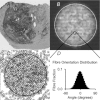
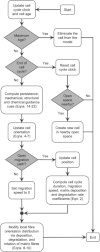
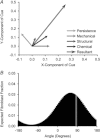
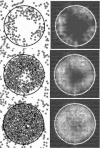



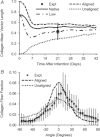
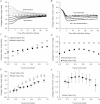
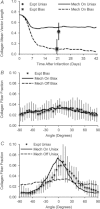
Similar articles
-
Coupled agent-based and finite-element models for predicting scar structure following myocardial infarction.Prog Biophys Mol Biol. 2014 Aug;115(2-3):235-43. doi: 10.1016/j.pbiomolbio.2014.06.010. Epub 2014 Jul 8. Prog Biophys Mol Biol. 2014. PMID: 25009995
-
Modifying the mechanics of healing infarcts: Is better the enemy of good?J Mol Cell Cardiol. 2016 Apr;93:115-24. doi: 10.1016/j.yjmcc.2015.11.028. Epub 2015 Nov 26. J Mol Cell Cardiol. 2016. PMID: 26631496 Free PMC article. Review.
-
Regional mechanics determine collagen fiber structure in healing myocardial infarcts.J Mol Cell Cardiol. 2012 May;52(5):1083-90. doi: 10.1016/j.yjmcc.2012.02.012. Epub 2012 Mar 7. J Mol Cell Cardiol. 2012. PMID: 22418281 Free PMC article.
-
Evolution of scar structure, mechanics, and ventricular function after myocardial infarction in the rat.Am J Physiol Heart Circ Physiol. 2010 Jan;298(1):H221-8. doi: 10.1152/ajpheart.00495.2009. Epub 2009 Nov 6. Am J Physiol Heart Circ Physiol. 2010. PMID: 19897714 Free PMC article.
-
Targeting the inflammatory response in healing myocardial infarcts.Curr Med Chem. 2006;13(16):1877-93. doi: 10.2174/092986706777585086. Curr Med Chem. 2006. PMID: 16842199 Review.
Cited by
-
Deep Learning for Strain Field Customization in Bioreactor with Dielectric Elastomer Actuator Array.Cyborg Bionic Syst. 2024 Aug 14;5:0155. doi: 10.34133/cbsystems.0155. eCollection 2024. Cyborg Bionic Syst. 2024. PMID: 39144697 Free PMC article.
-
Cell Sequence and Mitosis Affect Fibroblast Directional Decision-Making During Chemotaxis in Microfluidic Mazes.Cell Mol Bioeng. 2018 Aug 27;11(6):483-494. doi: 10.1007/s12195-018-0551-x. eCollection 2018 Dec. Cell Mol Bioeng. 2018. PMID: 31719895 Free PMC article.
-
Stretch-activated current in human atrial myocytes and Na+ current and mechano-gated channels' current in myofibroblasts alter myocyte mechanical behavior: a computational study.Biomed Eng Online. 2019 Oct 25;18(1):104. doi: 10.1186/s12938-019-0723-5. Biomed Eng Online. 2019. PMID: 31653259 Free PMC article.
-
Volumetric growth of soft tissues evaluated in the current configuration.Biomech Model Mechanobiol. 2022 Apr;21(2):569-588. doi: 10.1007/s10237-021-01549-y. Epub 2022 Jan 19. Biomech Model Mechanobiol. 2022. PMID: 35044527 Free PMC article.
-
Surgical reinforcement alters collagen alignment and turnover in healing myocardial infarcts.Am J Physiol Heart Circ Physiol. 2018 Oct 1;315(4):H1041-H1050. doi: 10.1152/ajpheart.00088.2018. Epub 2018 Jul 20. Am J Physiol Heart Circ Physiol. 2018. PMID: 30028201 Free PMC article.
References
-
- Bailón-Plaza A, van der Meulen MCH. A mathematical framework to study the effects of growth factor influences on fracture healing. J Theor Biol. 2001;212:191–209. - PubMed
-
- Camelliti P, Borg TK, Kohl P. Structural and functional characterisation of cardiac fibroblasts. Cardiovasc Res. 2005;65:40–51. - PubMed
-
- Chavali AK, Gianchandani EP, Tung KS, Lawrence MB, Peirce SM, Papin JA. Characterizing emergent properties of immunological systems with multi-cellular rule-based computational modeling. Trends Immunol. 2008;29:589–599. - PubMed
-
- Christman KL, Fok HH, Sievers RE, Fang Q, Lee RJ. Fibrin glue alone and skeletal myoblasts in a fibrin scaffold preserve cardiac function after myocardial infarction. Tissue Eng. 2004;10:403–409. - PubMed
Publication types
MeSH terms
Substances
Grants and funding
LinkOut - more resources
Full Text Sources
Medical

